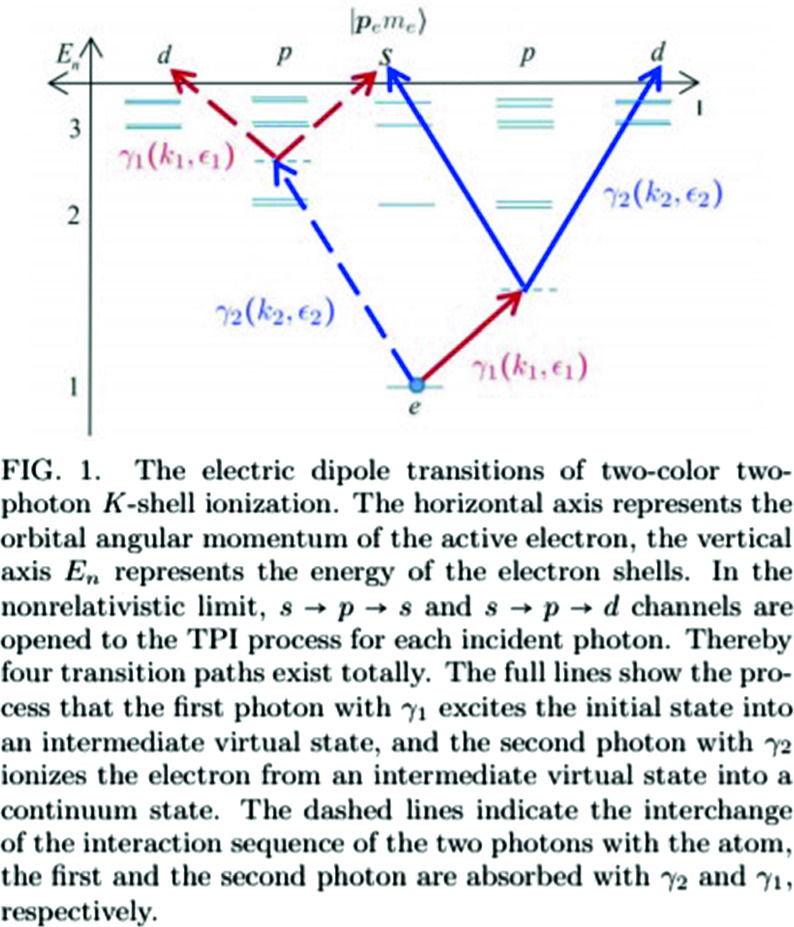https://doi.org/10.1140/epjd/s10053-021-00334-x
Regular Article – Optical Phenomena and Photonics
Relativistic calculations of two-color two-photon K-shell ionization
1
Abbe School of Photonics, Albert-Einstein-Straße 6, 07745, Jena, Germany
2
Theoretisch-Physikalisches Institut, Friedrich-Schiller-Universität Jena, Max-Wien-Platz 1, 07743, Jena, Germany
3
Helmholtz-Institut Jena, Fröbelstieg 3, 07743, Jena, Germany
4
GSI Helmholtzzentrum für Schwerionenforschung GmbH, Planckstrasse 1, 64291, Darmstadt, Germany
5
School of Physics and Engineering, ITMO University, Kronverkskiy pr. 49, 197101, St. Petersburg, Russia
Received:
7
September
2021
Accepted:
19
December
2021
Published online:
4
February
2022
We investigate the two-color two-photon K-shell ionization of neutral atoms based on the relativistic second-order perturbation theory and independent particle approximation. Analytical expressions for the relativistic and nonrelativistic total cross sections are derived in terms of radial transition amplitudes and Stokes parameters. Particular attention is paid especially to how the two-photon ionization total cross section depends on the energy sharing and polarization of the two incident photons. We construct the nonrelativistic expressions of cross section ratios for different polarization combinations of the two incident photons. The numerical results of total cross section and cross section ratios show that the energy sharing of the two incident photons plays an essential role in two-photon K-shell ionization. Particularly, if the energies of the two incident photons are identical, the total cross section and cross section ratios will reach the minimum or maximum value. Moreover, due to the strong screening effects, we find strong deviations of the cross section ratios near the two-photon ionization threshold of the Ne atom.
© The Author(s) 2022
 Open Access This article is licensed under a Creative Commons Attribution 4.0 International License, which permits use, sharing, adaptation, distribution and reproduction in any medium or format, as long as you give appropriate credit to the original author(s) and the source, provide a link to the Creative Commons licence, and indicate if changes were made. The images or other third party material in this article are included in the article’s Creative Commons licence, unless indicated otherwise in a credit line to the material. If material is not included in the article’s Creative Commons licence and your intended use is not permitted by statutory regulation or exceeds the permitted use, you will need to obtain permission directly from the copyright holder. To view a copy of this licence, visit http://creativecommons.org/licenses/by/4.0/.
Open Access This article is licensed under a Creative Commons Attribution 4.0 International License, which permits use, sharing, adaptation, distribution and reproduction in any medium or format, as long as you give appropriate credit to the original author(s) and the source, provide a link to the Creative Commons licence, and indicate if changes were made. The images or other third party material in this article are included in the article’s Creative Commons licence, unless indicated otherwise in a credit line to the material. If material is not included in the article’s Creative Commons licence and your intended use is not permitted by statutory regulation or exceeds the permitted use, you will need to obtain permission directly from the copyright holder. To view a copy of this licence, visit http://creativecommons.org/licenses/by/4.0/.





